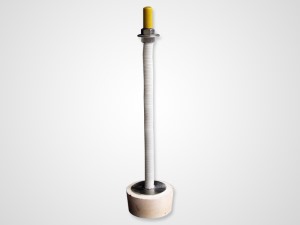Composition and properties of ramming materials for glass kilns
Unshaped refractory material constructed by ramming (manual or mechanical) method and hardened under the action of heating above normal temperature. It is composed of refractory aggregate with certain gradation, powder, binder, admixture, added with water or other The liquid is made by mixing. According to the material, there are high alumina, clay, magnesia, dolomite and zirconium ramming materials.
(1) Composition
According to the needs of use, ramming materials can be prepared from refractory aggregates and powders of various materials. At the same time, appropriate binders are selected according to the material and use requirements of refractory aggregates. Some ramming materials do not need binders but only add a small amount of flux to promote Its sintering. Sodium silicate, ethyl silicate and silica gel are commonly used as binders in acidic ramming materials. For alkaline ramming materials, aqueous solutions such as magnesium chloride and sulfate, as well as phosphates and their polymers are used as binders. .Also often use high carbon content, form carbon-bonded organics and temporary binders at high temperature. Chromium ramming materials are commonly used as binders. Glauber's salt is commonly used as a binder. Phosphate, sulfate, chloride and other inorganic substances are used as binders. When phosphoric acid is used as binders, during the storage process, phosphoric acid reacts with activated alumina in the ramming material to form water-insoluble aluminum orthophosphate precipitates. Coagulation and hardening. It is difficult to construct after losing plasticity. Therefore, in order to prolong the shelf life of the ramming material, an appropriate preservative must be added to prevent or delay the occurrence of coagulation and hardening, and oxalic acid is usually used as a preservative.
(2) Performance
Usually, the ramming material is mainly used for the parts that are in direct contact with the molten material. It is required that the refractory material must have good volume stability, compactness and erosion resistance, so high-temperature sintering or electrofusion raw materials are generally used. It is related to the construction method of the part used. Generally, the critical particle size is 8mm. Most of the ramming materials have low strength at room temperature before sintering, and some are not high in strength at medium temperature. Only when they reach sintering during heating can they obtain good bonding. The refractory performance and corrosion resistance of the ramming material can be obtained through the selection of high-quality raw materials, adjusting the reasonable ratio and careful construction. In addition to the high stability and corrosion resistance of the ramming material at high temperatures, its service life To a large extent also depends on the baking quality before use or the sintering quality in the second use. If the heating surface is sintered as a whole, without cracks and without separation from the bottom layer, the service life can be improved.
(3) Ramming materials used in glass furnaces
①The composition of zircon sand ramming material is percentage (mass): Zr0262, Si0232, A12032, Fe2030.5, the bulk density is greater than 3g\/cm3, the refractoriness is above 1790 degrees Celsius, and the particle size is 0.5mm. The binding agent is orthophosphoric acid and The aluminum 2 hydrogen phosphate made of aluminum hydroxide has strong adhesion, high strength and high temperature resistance, but it is easy to air dry and hard, and should not be stored for a long time. It is corrosive to the skin and inconvenient to use.
②Zirconium corundum ramming material (the French brand is ERSOL) commonly used AZS brick waste as refractory material. The composition of the ramming material is (percentage): A120348, Zr0230, Si0220, crystal phase is -Al203, mullite, baddeleyite zircon , glass phase, particle size is 5mm. When using, only need to add water to stir, bulk density is 3.2g\/cm3, porosity is 12%, the tendency of precipitation of bubbles is weak, and the corrosion resistance of glass liquid is very strong at 1400 degrees Celsius. It can also be used for sealing layer and mud slurry.
③Low shrinkage AZSC ramming material It is a certain amount of chromium-containing material introduced into the basic composition of AZS, the bulk density is greater than 2.9g\/cm3, the reburning line shrinkage (1400 degrees Celsius, 3h) is less than 0.2%, and the corrosion resistance of glass liquid is It is better than the above two kinds of ramming materials. It can also be used as sealing layer and casting material.

Related News
- Introduction of construction method of ramming material in intermediate frequency furnace
- How to choose the material of furnace lining
- The difference between rammer and castable
- Application direction of intermediate frequency furnace refining
- Introduction to the construction method of dry ramming material
- Do you know the production process and control points of breathable bricks?
- The application of argon blowing technology at the bottom of the intermediate frequency furnace
- Method for prolonging service life of intermediate frequency furnace lining
- In addition to diffused breathable bricks, there are those types of breathable bricks
- What are the advantages of coil cement
- Phenomenon analysis of failure of argon blowing of ladle permeable bricks and how to improve the rate of argon blowing
- How to Reduce Inclusions in Steel in Medium Frequency Induction Furnace Smelting
- What are the control points of nickel and cobalt elements in the smelting of medium frequency induction furnace?
- What are the requirements for the production materials of breathable bricks?
- How is the neutral ramming material of the intermediate frequency furnace made?
- Intermediate frequency charge manufacturer: design characteristics of coil cement
- Taking breathable bricks as an example, the basic knowledge of refractory materials is briefly described
- What are the requirements for the production materials of breathable bricks?
- Do you know that it is very important to beat the ramming material of the intermediate frequency furnace?
- What is the difference between dry and wet mixing of intermediate frequency furnaces?


